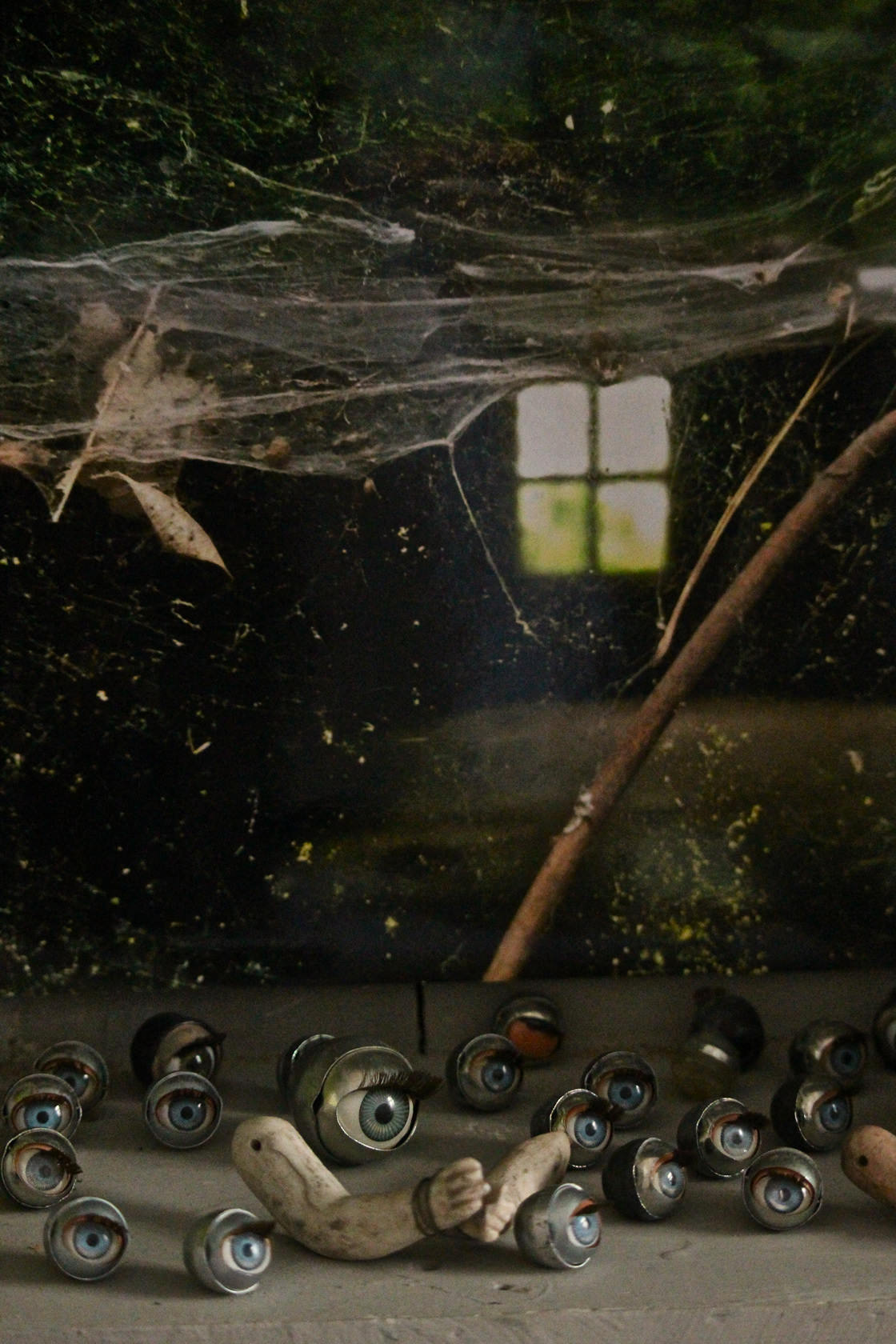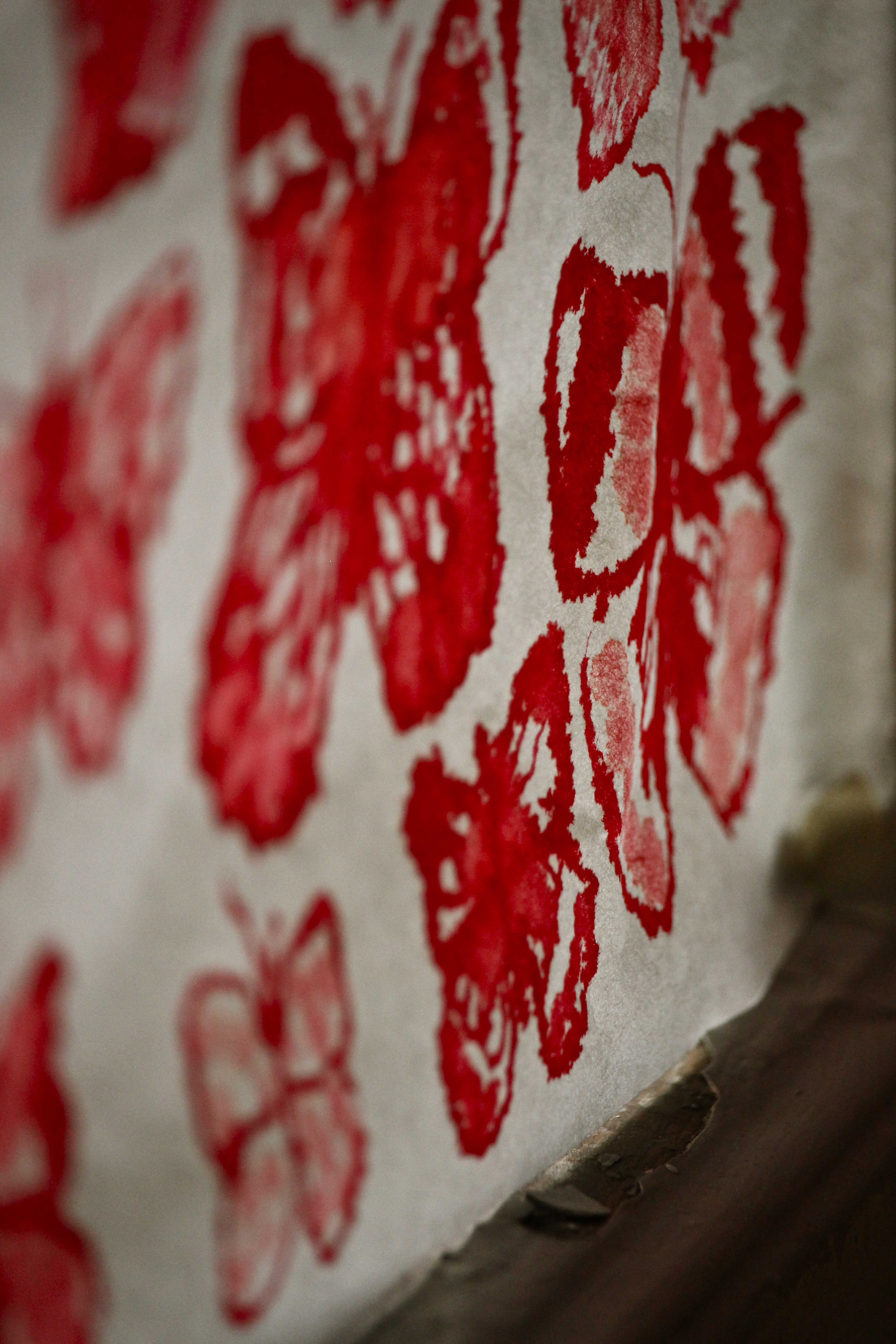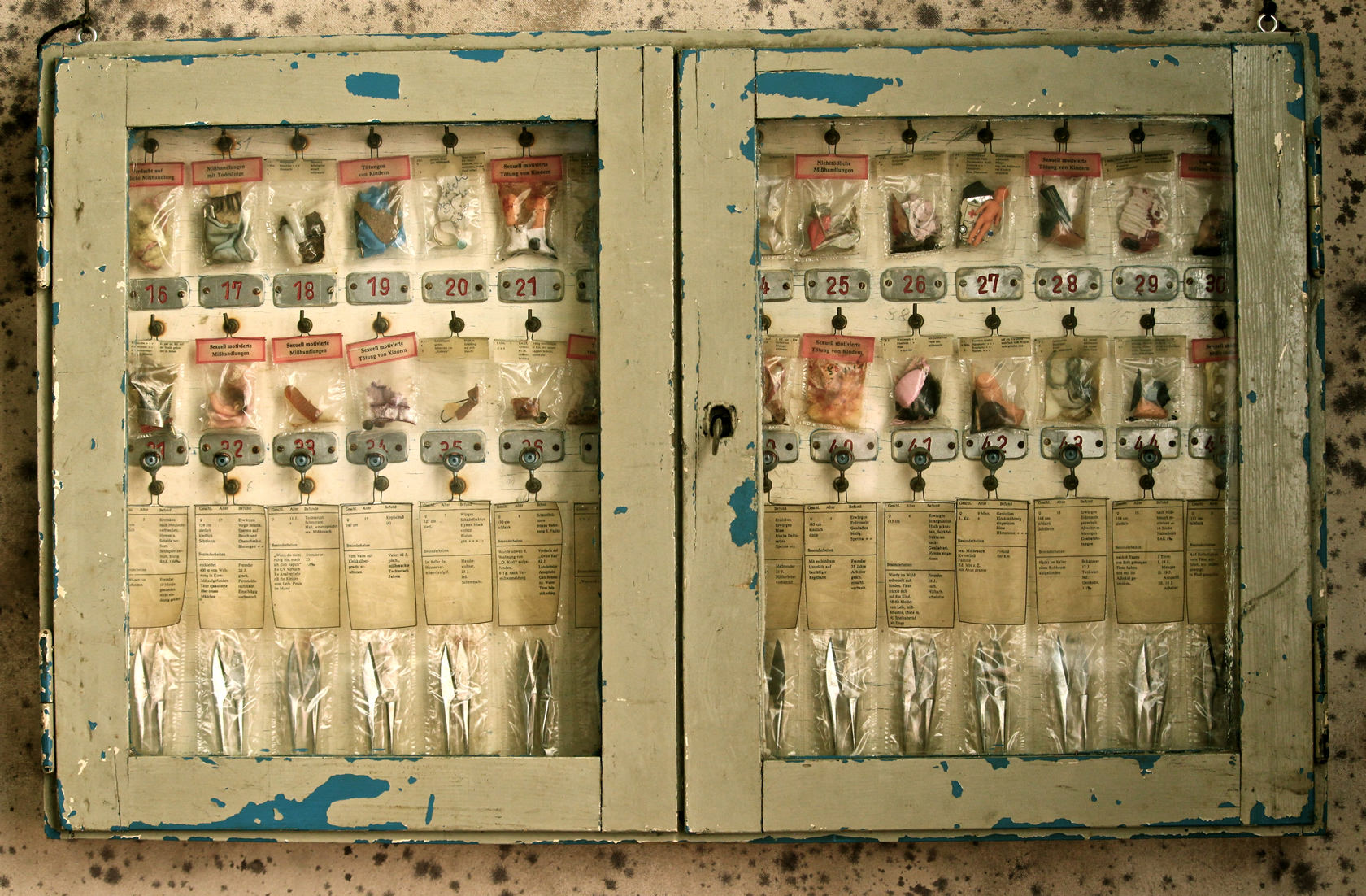
FOLLOWING THE FOOTPRINTS OF A CHILD’S BROKEN HEART – Gestapo “Children’s Home” Bad Sachsa/Germany, 2016 Lili Nalovi
photo: Lili Nalovi
OBJECT ART
The environmental object art installation „Following the Footprints of a Child’s Broken Heart“ about transgenerational trauma, is an assemblage of object art which, over the years, has intermittently been worked over by us. Time and time again, since 1991 until today, it has been extendet by new objects.
This installation takes a look at the trauma of two generations, the daughter’s trauma and the mother’s trauma.
On one side this environmental object art installation includes objects which are referring to the campaign against sexual violence and child sex abuse, which formed the focal point of Lili’s work spanning the years 1991 – 1998.
more...
For example the quilt „Scar Inscription“ or the musical box „Silent Night Holy Night“. There is a switch on the pedestal affixed with the words “Please switch on”. As soon as one flips the switch, a Christmas wreath begins to rotate to the tune “Silent Night, Holy Night”, an indication that even a traditional family celebration, for example Christmas, actually meant as a celebration for children, is also shamelessly used by relatives as an opportunity for sexual assault. A kitchen knife penetrates the little doll between her legs and the gray carpet upon which she stands is meant to indicate that sexual molestation of children often takes places within the family and again and again is swept under the rug.
Or the object art “Case 1-45 based on Circumstantial Evidence“. The oppressive case presentation, set in former key cabinets, are unfortunately a sad reality and are taken from the 1982 book: “Violence against Children: Neglect, Abuse, Sexual Assault and Killing of Children” written by the forensic doctor Elisabeth Trube-Becker. This work broaches the issue of how unfathomable painful and difficult it is for a victim, in hindsight and often without evidence, to helplessly stand by. With this work, it is our urgent need to symbolically search for traces and evidence so that the difficult traumata are not dismissed as made-up stories. For her objects „Silent Night, Holy Night“ and „Case 1-45 based on Circumstantial Evidence“ Lili was a awarded with the 1st prize in 1996 at the 12th“Salon de Printemps“ in Luxembourg, LAC Galerie du Ministre de la Culture Luxembourg.
And on the other hand, the objects of this environmental object art installation regarding transgenerational trauma, are referring to the fact that Lili’s mother, Ingrid von Seydlitz, born in 1934 and died on the 20th July 2019, was subjected to the ravaging effects of World War II. The fact that Lili’s mother even passed away on the 75th anniversary of the failed 20th July plot 1944 to assassinate Adolf Hitler, revealed to Lili again how deep her mothers destiny was connected to this event in her life, being one of the 46 children banished from their home to the „Gestapo-Kinderlager” Bad Sachsa, central Germany, after the failed attempted coup of July 20, 1944. General Walter von Seydlitz, Lili’s grandfather, had turned against the National Socialist dictatorship. A prisoner of war in 1943, in Stalingrad , he was one of the founders of the Federation of German Officers (BDO) as well as, the National Committee “Free Germany”. As a result of the failed coup attempt, Hitler and Himmler implemented the “Sippenhaft” policy of collective punishment for family members of those involved in the attempt. Numerous wife’s and mothers, along with older children, were held in prisons or concentration camps. The so called “children’s home” in Bad Sachsa served as a place to imprison the youngest children.
After 72 years, in August 2016, Lili traveled with her 82 year old mother back to Bad Sachsa. Today, four of the original 7 houses still exist. Mother and daughter had absolutely no contact for over 11 years due to the painful wounds and rejection that stood between them. The shared experience of returning to the place where such oppressive and traumatic events occurred, in many aspects was transformative for both of them. Thus, becoming a very touching and reconciliatory experience. For a long time, Lili was deeply aware that her mother’s trauma from the war, tied her hands and closed her heart. Through physically being in Bad Sachsa together, Lili realized further how deeply a mother and daughter are subconsciously connected. They stayed 3 days in Bad Sachsa working on site.
Later, the work continued in our art space, a whole room was dedicated to this theme by creating an environmental object art installation. In 2018, we were invited to the exhibition “Wonderland1” an Art Lab at “Kornversuchspeicher” in Berlin, and thus the installation even expanded more.
This environmental object art installation includes our intent and focus to transform negative vibrations into positive or from darkness to light. The central object „Towards Light – Healing & Hope“ is a huge old window, whose glas is covered by japanese rice paper drawn over and over with several hundreds of blood-red ink butterflies. The butterfly is a symbol of change and transformation, also a symbol of change and emotional processes of humans. The blood-red butterflies are a metaphor of the painful emotional transformation process and the treatment of trauma. Nevertheless, the fact remains that a relatively unattractive caterpillar, through the process of metamorphosis, transforms itself into an ethereal entity and can then freely lift itself in the air towards the sunlight; such is the work in “Healing & Hope“.
Healing and Hope, when trauma can be worked on long-term and open itself up, an understanding and empathy between the generations can be developed. So with this environmental object art installation, we hope to encourage the dialogue between generations, especially between war children and grandchildren in Germany.
close

FOLLOWING THE FOOTPRINTS OF A CHILD’S BROKEN HEART, Environment Kornversuchsspeicher Berlin, 2018 Lili & Jesko
photo: Klaus A. Mellenthin

FOLLOWING THE FOOTPRINTS OF A CHILD’S BROKEN HEART, Environment Kornversuchsspeicher Berlin, 2018 Lili & Jesko
photo: Klaus A. Mellenthin

FOLLOWING THE FOOTPRINTS OF A CHILD’S BROKEN HEART, Environment Kornversuchsspeicher Berlin, 2018 Lili & Jesko
photo: Klaus A. Mellenthin

FOLLOWING THE FOOTPRINTS OF A CHILD’S BROKEN HEART, Environment Kornversuchsspeicher Berlin, 2018 Lili & Jesko
photo: Klaus A. Mellenthin

FOLLOWING THE FOOTPRINTS OF A CHILD’S BROKEN HEART, Environment Kornversuchsspeicher Berlin, 2018 Lili & Jesko
photo: Klaus A. Mellenthin

FOLLOWING THE FOOTPRINTS OF A CHILD’S BROKEN HEART, Environment Kornversuchsspeicher Berlin, 2018 Lili & Jesko
photo: Klaus A. Mellenthin

FOLLOWING THE FOOTPRINTS OF A CHILD’S BROKEN HEART, Environment Kornversuchsspeicher Berlin, 2018 Lili & Jesko
photo: Klaus A. Mellenthin

FOLLOWING THE FOOTPRINTS OF A CHILD’S BROKEN HEART, Environment Kornversuchsspeicher Berlin, 2018 Lili & Jesko
photo: Klaus A. Mellenthin

FOLLOWING THE FOOTPRINTS OF A CHILD’S BROKEN HEART – Gestapo “Children’s Home” Bad Sachsa/Germany, 2016 Lili Nalovi
photo: Lili Nalovi

FOLLOWING THE FOOTPRINTS OF A CHILD’S BROKEN HEART – Gestapo “Children’s Home” Bad Sachsa/Germany, 2016 Lili Nalovi
photo: Lili Nalovi

FOLLOWING THE FOOTPRINTS OF A CHILD’S BROKEN HEART – Gestapo “Children’s Home” Bad Sachsa/Germany, 2016 Lili Nalovi
photo: Lili Nalovi

THE 46 CHILDREN OF JULY 20th 1944 – THE SO-CALLED CHILDREN OF BAD SACHSA, 2016 Lili Nalovi
photo: Lili Nalovi

FOLLOWING THE FOOTPRINTS OF A CHILD’S BROKEN HEART – Gestapo “Children’s Home” Bad Sachsa/Germany, 2016 Lili Nalovi
photo: Lili Nalovi

FOLLOWING THE FOOTPRINTS OF A CHILD’S BROKEN HEART – Gestapo “Children’s Home” Bad Sachsa/Germany, 2016 Lili Nalovi
photo: Lili Nalovi

FOLLOWING THE FOOTPRINTS OF A CHILD’S BROKEN HEART – Gestapo “Children’s Home” Bad Sachsa/Germany, 2016 Lili Nalovi
photo: Lili Nalovi

DISGUST & VIOLATION,1996 Lili Nalovi
photo: Lili Nalovi

TRAITOR BLOOD, 2016 Lili Nalovi
photo: Lili Nalovi

FRAGILE,1998 Lili Nalovi
photo: Lili Nalovi

CIRCUMSTANTIAL CASE 1 – 45, 1995 Lili Nalovi
display cabinet/things found lying around/tables (from the book: Violence against the child, E. Trube-Becker, criminal pathologist), 50 x 80 x 5 cm [19.7 x 31.5 x 2 in]
photo: Lili Nalovi

DISGUST & VIOLATION,1996 Lili Nalovi
photo: Lili Nalovi

CIRCUMSTANTIAL CASE 1 – 45, 1995 Lili Nalovi
display cabinet/things found lying around/tables (from the book: Violence against the child, E. Trube-Becker, criminal pathologist), 50 x 80 x 5 cm [19.7 x 31.5 x 2 in]
photo: Lili Nalovi

SILENT NIGHT, HOLY NIGHT, 1995 Lili Nalovi
base-switch/Christmas wreath/musical clock/photos (from the book: Violence against the child, E. Trube-Becker, criminal pathologist), 100 x 40 x 40 cm [39.4 x 15.7 x 15.7 in]
photo: Lisa Hammel

